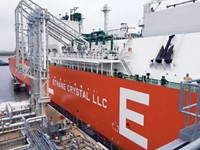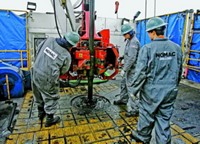Advertisement
Grab your lab coat. Let's get started
Welcome!
Welcome!
Create an account below to get 6 C&EN articles per month, receive newsletters and more - all free.
It seems this is your first time logging in online. Please enter the following information to continue.
As an ACS member you automatically get access to this site. All we need is few more details to create your reading experience.
Not you? Sign in with a different account.
Not you? Sign in with a different account.
ERROR 1
ERROR 1
ERROR 2
ERROR 2
ERROR 2
ERROR 2
ERROR 2
Password and Confirm password must match.
If you have an ACS member number, please enter it here so we can link this account to your membership. (optional)
ERROR 2
ACS values your privacy. By submitting your information, you are gaining access to C&EN and subscribing to our weekly newsletter. We use the information you provide to make your reading experience better, and we will never sell your data to third party members.
Business
Petrochemicals
Cheap raw materials and a muted industry downturn add up to good times for U.S. companies
by Alexander H. Tullo
March 7, 2011
| A version of this story appeared in
Volume 89, Issue 10

Reports of the death of the U.S. petrochemical industry, to borrow words attributed to Mark Twain, have been greatly exaggerated.
As recently as five years ago, U.S. petrochemical executives resigned themselves to a mediocre future. The U.S. was the last place on Earth anyone wanted to build a petrochemical plant. A rise in natural gas prices had put U.S. chemical makers at a disadvantage to their counterparts in Europe, Asia, the Middle East, and elsewhere.
At the time, this disadvantage wasn’t an immediate problem. The world economy was booming, and demand for petrochemicals was so high that it didn’t matter how much it cost to make them. But many observers thought the day of reckoning would come with the industry’s next downturn, which was expected in 2007 and 2008. At that point, a swarm of new capacity in the Middle East and Asia—mostly meant to feed a growing Chinese appetite—was to chase North American petrochemicals out of the international market for good. And U.S. demand, it was thought, wasn’t going to pick up the slack.
For a number of reasons, that didn’t happen. The new capacity didn’t start up as soon and as forcefully as planned, especially in the Middle East. Asia was equal to the task of absorbing new petrochemical output. And U.S. demand bounced back considerably from the severe recession.
But the biggest factor of all has been competitiveness. Not only has natural gas regained its advantage over petroleum, the main feedstock in Europe and Asia, in the U.S., but it’s cheaper with respect to petroleum than it has ever been. Only the Middle East exceeds North America’s edge in petrochemical economics. And companies are even considering building new plants in North America once more.
Steve Zinger, global olefins business director for the Houston-based consultancy Chemical Market Associates Inc. (CMAI), says the recession and financial crisis had a far greater impact on the petrochemical industry than the subsequent capacity-driven downturn. “I think we have seen the worst of the downturn in this industry,” he says. “And it wasn’t that bad actually. It will take a couple of years to fill the excess capacity, but the downturn hasn’t been as bad as some previous downturns.”
A flood of new petrochemical capacity—about 10 million metric tons of it, representing roughly 7% of the global market—did finally open in 2010. And more capacity is slated for Asia again this year.
But China has absorbed much of the new output. “Chinese demand has rebounded very well,” says Grant Thomson, president of olefins and feedstock at Nova Chemicals. “It is a part of the world that continues to surprise us. Every time we say something like ‘Chinese demand isn’t going to be quite as strong next year,’ it turns out that it is.”
In the Middle East, meanwhile, the new units have mostly reached mechanical completion, but plant managers have had difficulty actually ramping up production. Instead of their normal operating rates of about 90%, Zinger says, Middle Eastern plants have been running at average rates closer to 75% or 80%.
Even in the hydrocarbon-rich region, energy firms have found it challenging to supply feedstock to all of the new plants. Engineering talent needed to start up the facilities has been in short supply around the booming region. Marketing the new output hasn’t been easy. And sanctions have made it difficult for Iranian companies to operate their plants and export petrochemicals.
Ironically, the turmoil in the Middle East isn’t having much impact on the petrochemical industry except to push up oil prices. Algeria, Libya, Egypt, and Bahrain aren’t significant petrochemical-exporting countries. Many countries that are—such as Saudi Arabia, Kuwait, the United Arab Emirates, and Qatar—haven’t experienced nearly as much political upheaval. A disruption of the Suez Canal would affect volumes from the Persian Gulf headed for Europe, but even during the height of the recent tensions in Egypt, the canal remained open.
In addition to China, Europe is a potential target market for Middle Eastern petrochemical output. Gerd Löbbert, executive vice president for polyolefins at European chemical major Borealis, reports that the region saw a greater than expected recovery in polyolefin demand last year.
“Since the beginning of 2009, we have seen more imports into Europe,” Löbbert says. “We expect this trend to continue in 2011, but due to outages and interruptions at European producers, the market still had to face some shortages in certain areas.”
Last year, a report from the consulting firm KPMG warned that some 26% of European ethylene capacity faced being shut down amid the flood of offshore capacity. Löbbert isn’t expecting anything of the sort. “In terms of capacity reduction, we would not be surprised to see single plant closures but do not expect a wave of closures,” he says.
In North America, the talk is of expansion, not contraction. The region saw petrochemical demand surge in 2010, led by major ethylene derivatives such as polyethylene and polyvinyl chloride. U.S. demand for ethylene increased 6% in 2010, according to CMAI. Globally, demand increased by 8%, a significant improvement over normal growth rates of about 4.5%, Zinger says.
Exports have also held up well, Nova’s Thomson adds. “I remember people were saying that by 2010 there would be zero exports coming out of North America,” he says. “Last year as an industry we exported just short of 8 billion lb of polyethylene.”
Dan Carlson, general manager of base chemicals in the Americas at Shell Chemicals, says a few other export markets have been performing well, too. “The fibers market is really experiencing a major boom because of the shortage of cotton,” he says, noting that this has been good for ethylene glycol and acrylonitrile, which are used in polyester and acrylic fibers, respectively.
The credit for North America’s recent success, experts agree, should go to its feedstock advantage. “If we didn’t have that feedstock advantage, we wouldn’t be exporting so much and our operating rates and our profitability would be lower,” Zinger says.

The advantage comes from cheap natural gas. About 65% of U.S. ethylene capacity is based on ethane, which is extracted from natural gas. Regions such as Europe and Asia primarily use oil-derived feedstocks such as naphtha. When the ratio of the price of 1 barrel of oil to the price of 1 million Btu of natural gas is greater than eight, North American producers have the edge.
Back when observers were writing off the U.S. petrochemical industry, the ratio was below that with great regularity. In recent years, though, the ratio has been breaking 20. “Every day, we seem to be hitting new all-time highs on the oil-to-gas ratio,” Carlson says.
What changed over the past five years is underground shale, which gas exploration firms have learned to tap with horizontal drilling and hydraulic fracturing. Shale accounted for about 0.5 trillion cu ft of natural gas production in 2005, according to Lippman Consulting. Now, it is responsible for 4.5 trillion cu ft, close to 20% of U.S. natural gas output, the Department of Energy says.
Observers expect the U.S. feedstock advantage to last for a while. The only way it won’t is if oil prices decline sharply or if new demand for natural gas strains the market. “It doesn’t look like that is in the cards for the next five years and probably much longer,” CMAI’s Zinger says.
North American producers can take advantage of the cheap feedstock in four ways, Shell’s Carlson explains. First, producers are converting existing crackers to light feedstocks as much as possible. Second, they are restarting crackers that have been idle, as Chevron Phillips Chemical and Eastman Chemical recently did. Third, producers will seek to expand existing crackers. And fourth, a firm could start a “grassroots project by building a whole new cracker, although, of course, that’s the most difficult and expensive choice to make,” Carlson says.
Normally, crackers have some flexibility to incrementally use more ethane and less of other feedstocks as the market requires. Recently, some firms decided to make capital investments to enable a bigger shift. Last year, Shell completed such a project at its Norco, La., and Deer Park, Texas, crackers. Nova and LyondellBasell Industries have engaged in similar projects.
In December, Dow Chemical unveiled a plan to increase ethane-cracking capabilities at its Gulf Coast ethylene crackers by 20 to 30% over the next two to three years. In addition, the company is considering a joint venture to build a fractionator that would separate ethane from natural gas.
Raja Zeidan, Dow global vice president of feedstocks and risk management, says it is too early to get into specifics about what sites would be modified and how. He does say the firm’s crackers would “consume more ethane without losing the flexibility to consume the current feedstocks.”
When ethylene producers crack more ethane, they produce fewer coproducts such as propylene and butadiene. North America is now experiencing a severe shortage of these petrochemicals. In propylene, the situation has been compounded by poor profitability and low operating rates in the oil refining industry, which generates propylene as a coproduct. Annual U.S. propylene output has declined 20%, or about 6 billion lb, in only a couple of years, CMAI’s Zinger says.
Last October, the pipeline firm PetroLogistics started up a 1.2 billion-lb-per-year propane dehydrogenation plant in Houston to help cover the shortfall. Zinger says the plant is a drop in the bucket. “We are still structurally short in the propylene market,” he says.
The propylene shortfall, along with the growing ethane advantage, was a big part of Eastman’s rationale for restarting a cracker at its Longview, Texas, complex.
Eastman has four ethylene crackers at the site; one can produce about 1 billion lb per year, and the other three are each about half that size. When Eastman sold its polyethylene business to Westlake Chemical in 2007, it decided to shutter the three smaller units. It closed one unit in 2008, idled another in 2009, and never got around to closing the third.
“And then the world changed with the shale-gas generation and the associated ethane,” says Ronald C. Lindsay, executive vice president of performance chemicals, intermediates, and operations support at Eastman. “We changed our view of the crackers as well.” Eastman brought one of the closed units back on-line in December. Restarting the other one, however, would be too costly, he says.
Additional propylene output was another reason for bringing the unit back on-line. Eastman makes propylene derivatives such as aldehydes, alcohols, and plasticizers in Longview. “With the cracker restart, it reduces the amount of propylene we purchase,” Lindsay says.
In addition to bringing idled capacity back on-line, petrochemical executives for the first time in a decade are considering investing in new capacity in the U.S. Much of the excitement is because of the Marcellus shale formation, which extends from western New York through West Virginia. As the natural gas resource is developed, competing ideas are emerging regarding what to do with the new ethane stream.
Some want to build a cracker locally. West Virginia Gov. Earl Ray Tomblin formed a task force last month to help develop an ethylene plant in his state. The task force will conduct a feasibility study, identify interested companies, and locate a plant site. Late last year, Bayer MaterialScience offered its West Virginia sites as potential locations. Gregory S. Babe, the firm’s North American head, is on the task force.
Others intend to take the natural gas out of the region by piping it to the Gulf Coast. El Paso Corp. and Spectra Energy plan to bring 60,000 bbl per day of ethane from Pennsylvania to the Gulf Coast by 2013. MarkWest Energy Partners and Sunoco plan to ship 50,000 bbl per day to the Gulf Coast by 2012.
Companies are already considering using the ethane to feed new capacity on the Gulf Coast. According to a November report in the Taipei Times, Taiwan’s Formosa Plastics is considering spending up to $1 billion to expand its Point Comfort, Texas, petrochemical complex. A Formosa spokesman says the plan is “still in evaluations and discussions, but no go-ahead decisions have been made.”
Advertisement
Zinger sees benefits to both cracking ethane locally and shipping it to the Gulf Coast. Cracking it locally means no pipeline costs. The Gulf Coast, on the other hand, has more existing infrastructure.
Nova’s Thomson is skeptical that a cracker will be developed locally. “If you are going to build a cracker, then you have to build derivative capacity as well,” he says. “When you look at the types of dollars that are required to invest in that, I still think it is hard to economically justify.”
Admitting a bias, Thomson proposes a solution that combines a little of both ideas: Build a pipeline from the Pittsburgh area to Sarnia, Ontario, where Nova operates a petrochemical complex and where considerable petrochemical infrastructure is in place. Sarnia, he points out, is closer than the Gulf Coast or even Chicago.
Thomson takes it as a positive sign for the North American petrochemical industry that companies are looking at investing there again. “There has been a fairly significant change,” he says. “Five years ago, we were hearing things like there will never be another plant built in North America. I am actually thrilled to see companies in North America talking about expansion.”






Join the conversation
Contact the reporter
Submit a Letter to the Editor for publication
Engage with us on Twitter